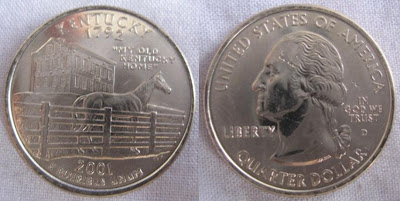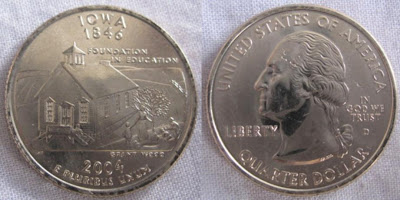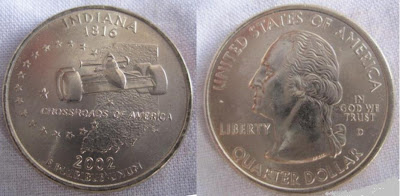Coin collection as a hobby has has always been seen as an eccentric one and collectors like myself are thought to be oddballs(not that we are totally normal ;). Like all other collectors would have been looked on as a freak at some or the other time and know what the popular perception regarding collectors is, may understand where I am getting at. This is a little attempt to change the perception of non-collectors, and I believe that there are quite a few regular visitors of this blog who are just having a passive interest and do not collect seriously or do not spend a size able amount on collecting.
Perception: Coin collection is exclusively for the rich baron types who have lots of spare money at their disposal.
Reality: Just about anyone, even a school student can collect, starting from the coins he or she may get in circulation or from perhaps some old coins from some relative. The only matter of concern is that one can only spend as much as the pocket.
Perception: coin collecting is about reckless spending of money.
Reality: Nothing can be farther from the truth. Even if you are as rich as the king of Egypt, you still cannot buy all the coins in the world. So to maximize the collection, the collector looks for the cheapest deal and is aware of the market prices of what he or she is buying. Most collectors are in the habit of a preliminary market survey before buying anything worth money. One may ask a fellow collector or cross check the value with some other dealer before buying.
Perception: Are you out of your mind?! What sort of a fool would spend 2000 rupees on a 100 rupee coin? You cannot get more than 100 rupees of worth if you give 100 rupees at a shop.
Reality: As a collector, I find this to be the silliest notion that I have ever encountered. If the face value of a coin is 10 rupees, then obviously one won't give it away for a worth of less than 10 rupees. But that's not all. Any coin can have value greater than its face value. In the case of 100 rupee coins, the coin is made of silver and easily has a value of 600 rupees on metal value alone, and the manufacturing cost to the government or mint is an estimated 1000 rupees, or about 10 times the face value. By the time the coin comes into the market, its value crosses 2000 rupees.(These are the estimates at the time when I post this, and values only increase over time). The value of a rare coin can be hundreds or even thousands of times its face value, based on the demand alone. Say if 4000 Tilakji coins are minted, and there are millions of collectors in India, then obviously the value of such a coin is going to be very high.
Perception: Spending on coins is blocking your money. Its a waste of money.
Reality: Buying coins a very good investment, the only prerequisite is that you need to have sufficient knowledge on the item and be aware of the market values. The prices go up more than prices of silver, gold or crude oil. The resale value of coins is unlike any other. People buy electronic items like blackberry for 40k and no one bats an eyelid, but when a collector spends 2500 on a 100 rupee coin he is said to be an idiot. The blackberry's value will be less than half in a few years and after use it has no resale value, whereas the value of coin will more than double in the same time. It has to be kept in mind that a collector invests in coins the money which he would otherwise have spent on movies, pizzas or electronic items and the like.
Perception: I heard that some coin was sold for lakhs of rupees. The buyer must be loaded with tons of spare money and he must be a real idiot. No one is going to buy for a higher price as the price is already too high.
Reality: The buyer would be having lots of money if he buys a single coin for over one lakh, that is undeniable. Personally I won't think of buying any item having cost more than 20 grand. But the catch is, any item which is fetching that high would definitely be a very very rare item, and prices of rare items go up very quickly indeed. Every time we think that the price won't go higher, we are proven wrong. The land resource 2 rupee was originally sold at 500 rupees, and that was thought to be high at that time. Now the price is 80-90k, and going up fast. The 1 rupee of 1960 was recently sold for 2.25 lakh, so you may dismiss the buyer as a complete idiot, but whenever it is sold next time, I believe the price would be in excess of 4 lakh. The 1913 liberty head nickel was sold for the first time in 1920 for 500$ apiece, or about 10,000 times the face value. Many may have dismissed the buyers as idiots, but its current value has risen to 5 million $ after changing hands many times over. Who would have thought the value would rise this much? And that the value would rise even further is inevitable.
Perception: I have over 100 rare coins which I would like to sell for thousands of rupees, East India Company coins with Indian deities which I want to sell for a couple of lakhs and also one 100 rupee coin which I want to sell for one crore. Any buyer please contact me @ 9899573xyz.
Reality: The only person you are fooling is yourself. Firstly, if you have 100 coins, then how can they be rare? The East India company coins with Indian deities are fake and have zero value. A 100 rupee coin is made of silver and the cost is a few thousand, but that is the case if the coin is in a set, and not a loose coin. A loose 100 rupee coin has value around the metal value, and there is no way the value of the set can go up to a crore. If you think that the value of any coin not found in circulation would be of the order of thousands or a few hundreds, then you are sorely mistaken. A coin not being in circulation does not mean it is rare; and if every coin had that sort of value, then no one would be able to collect because then the cost of collection would be too high.
Perception: coins are a way to earn quick bucks. I can simply find some valuable coin in circulation and sell it for thousands, or perhaps I can buy a coin at low cost and sell to some wealthy collector at really high cost.
Reality: Another delusion. As far as my experience goes, there is no such thing as quick money. Even if there is, it will never give you satisfaction. An iron clad rule of life: "Anything that comes easy is worthless". As far as coins go, if you can find something in circulation, then it won't be rare and not having high value. Collectors are always sharp at getting things in circulation. So if you are not a collector, forget about finding something valuable in circulation. Still, it is not uncommon to find items having value as something above face value in circulation. You canNOT make a valuable collection without buying, and for that sufficient knowledge is needed in the first place. The only way to make money through coins is through long term investments, and not any frivolous stupid activity.
P.S. An idiot once said to me that he had bought some East India company coins with Indian deities for thousands, thinking that he would sell them for a crore or so, and then he would marry Katrina Kaif. Such delusions! A modern day Shiekh Chilli, nevertheless.
"Only two things are infinite: the universe and human stupidity, and I am not so sure about the former."
-Albert Einstein
 Nebraska, nicknamed the "Cornhusker State," was admitted into the Union on March 1, 1867, becoming our Nation's 37th state. Nebraska's quarter depicts an ox-drawn covered wagon carrying pioneers in the foreground and Chimney Rock, the natural wonder that rises from the valley of North Platte River, measuring 445 feet from base to tip. The sun is in full view behind the wagon. The coin also bears the inscriptions "Nebraska," "Chimney Rock" and "1867".
Nebraska, nicknamed the "Cornhusker State," was admitted into the Union on March 1, 1867, becoming our Nation's 37th state. Nebraska's quarter depicts an ox-drawn covered wagon carrying pioneers in the foreground and Chimney Rock, the natural wonder that rises from the valley of North Platte River, measuring 445 feet from base to tip. The sun is in full view behind the wagon. The coin also bears the inscriptions "Nebraska," "Chimney Rock" and "1867". Montana, nicknamed "Big Sky Country," was admitted into the Union on November 8, 1889, becoming our Nation's 41st state. The reverse of Montana's quarter features a bison skull depicted above the diverse Montana landscape with the inscription "Big Sky Country." The coin also bears the inscriptions "Montana" and "1889."
Montana, nicknamed "Big Sky Country," was admitted into the Union on November 8, 1889, becoming our Nation's 41st state. The reverse of Montana's quarter features a bison skull depicted above the diverse Montana landscape with the inscription "Big Sky Country." The coin also bears the inscriptions "Montana" and "1889." Missouri became the 24th state on August 10, 1821, as a part of the Missouri Compromise. The Missouri quarter depicts Lewis and Clark's historic return to St. Louis down the Missouri River, with the Jefferson National Expansion Memorial (Gateway Arch) in the background. The quarter is inscribed "Corps of Discovery 1804-2004".
Missouri became the 24th state on August 10, 1821, as a part of the Missouri Compromise. The Missouri quarter depicts Lewis and Clark's historic return to St. Louis down the Missouri River, with the Jefferson National Expansion Memorial (Gateway Arch) in the background. The quarter is inscribed "Corps of Discovery 1804-2004".

























